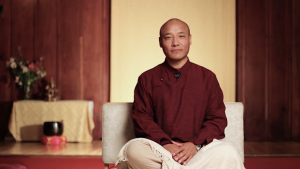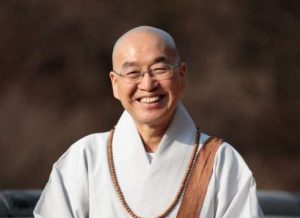As a poet, author, translator, and founder of the Everyday Zen Buddhist Foundation, Norman Fischer’s contributions to Buddhism in the West are significant. With some 50 years of Zen practice under his belt, he has published numerous essays on Buddhism. His new book, When You Greet Me I Bow: Notes And Reflections From A Life In Zen (Shambhala Publications 2021), offers an exciting sample of these works. Edited by Cynthia Schrager, the collection includes current comments by Fischer, as well as inspiring poems, koans, and stories from various Buddhist traditions. The essays themselves span several decades and cover a variety of themes, including women in Buddhism, relationships, inter-religious dialogue, the monastic life, and reflections on Buddhism in the East and the West.
Although Fischer’s work is divided into four chapters, the collection is eclectic. Because of this, they need not be read in any particular order.
In the author’s own words:
In any case, what you read here is the record of a certain category of the thinking of a certain person who has never been stable, sensible, or coherent but has rather (like any of us, if we were to notice closely enough!) been in constant flux, shift, and burble: a changeable if discernible (to others, if not to himself) shape defining an empty space. (xviii)
In the Soto Zen that I practice, working with phrases is practiced in a fuzzy and disorganized way. There is no curriculum and no particular format. This has suited me, because I find I resist things that are too well organized; real life is fuzzy, and spiritual approaches that seem organized (they never really are organized; they just seem to be) and therefore suggest progress and reasonable development strike me as less honest than disorganized approaches that admit progress is a problematic concept to begin with. (142)
True to the Soto Zen tradition—and one could even say to the human experience—Fischer’s writing is dynamic, it is “fuzzy,” and sometimes it appears contradictory. Far from being off-putting, the author’s earnestness and his vulnerability are what make the collection such a pleasure to read. We are not being lectured by some great spiritual master, instead we are meeting another human being who encourages us in every way to celebrate our aliveness. Relationships are everything, he writes, and what connects us are our imperfections, our suffering, and our attempts to keep going.
Some of the pieces are clearly a product of past decades, while others are recent and address very pertinent issues. Either way, Fischer’s reflections are poignant and thought-provoking, and his admission that he lightly reworked some of the pieces is almost disappointing—only because reading his candid words had me wondering how much more candid they could have been had they been left untouched.
Humble in his practice and in his writing, Fischer reminds us that the concept of the teacher is problematic because it suggests that one being has already attained enlightenment:
In Zen, teaching is a dubious proposition. That’s why it’s called “scattering dust and sand.” Like Cuiwei, with his “ladleful of foul water,” Zen ancients recognized that all religious and moral systems, however necessary, must be taken lightly. They will always be partial and therefore potentially destructive in this checkered world. Even the buddhas, as Zen sees them, are still working on being able to understand their own lives, and ours, well enough even to be able to spread the half-truths that constitute Buddhist teaching. (306)
Instead of presuming to know all the answers, Fischer encourages the reader to approach their practice with an inquisitive mind:
Ask yourself: from what perspective do you look at your body? From inside, peering out from the body’s eyes? Or from the outside, as if you were looking at it in a mirror? But how is it possible for the body to be external to itself? No, that can’t be. The body must be contained in the experience of looking, so what you see and call “my body” must be something else. (88)
Drawing from a number of traditions, including Judaism and different schools of Buddhism, Fischer’s hodgepodge approach is reflective of Buddhism in America.
Fischer writes:
People ask me sometimes how I can practice both Judaism and Buddhism at the same time. Don’t I get confused? I respond in a typically Jewish way, with a question: Why not? Where’s the confusion? Buddhism seems to have no problems with this, and so far as I know, my Buddhist colleagues do not complain. At first it looked like the Jewish community was going to be a bit nervous about this mixing, but now there is a thriving international Jewish meditation movement that has influenced several of the more liberal denominations, and even some of the conservative ones. I’ve also had experience meditating with Christians, who, like many Jews, practice meditation as a way to gain deeper access to the teachings of their own tradition. (154)
I learned from [Jon Kabat-Zinn] that what I’d read in the sutras was true: the path is available to everyone and must be shared, and to guide others effectively you must be willing to use whatever comes to hand (“skillful means,” as it’s called in Mahayana Buddhism). (176)
As we catch glimpses into Fischer’s life journey, it becomes increasingly apparent how eclectic, impactful, and innovative his approach has been. Together with the late Rabbi Alan Lew, he founded the Makor Or Jewish meditation center in San Francisco. He also lived for several years at Tassajara Zen Mountain Center, the San Francisco Zen Center’s monastic community in the Los Padres National Forest. He was abbot of Green Gulch Farm Zen Center near San Francisco. And over the years, he has worked and practiced with people from all walks of life including lawyers, hospice patients, and Google employees. His ability to connect, to adapt, and to relate are evident and his reflections are likely to inspire in the reader a deep sense of what it means to be human.
Reference
Fischer, Norman. 2021. When You Greet Me I Bow: Notes And Reflections From A Life In Zen. Boulder, CO: Shambhala Publications.
Related features from Buddhistdoor Global
United by Our Common Vows: Tenku Ruff on Soto Zen in North America
The Most Intimate
The Way of Ordinary Life: An Interview with Karen Maezen Miller
Visions from the Zen Mind: Zen Paintings and Calligraphy at the Los Angeles County Museum of Art
The Gift of Zazen: Angie Boissevain
The Lotus is a Form of Dance: Reverend Teijo Munnich
Spirituality as the Transformation of Daily Life: Living Buddhism in 21st Century Japan
















